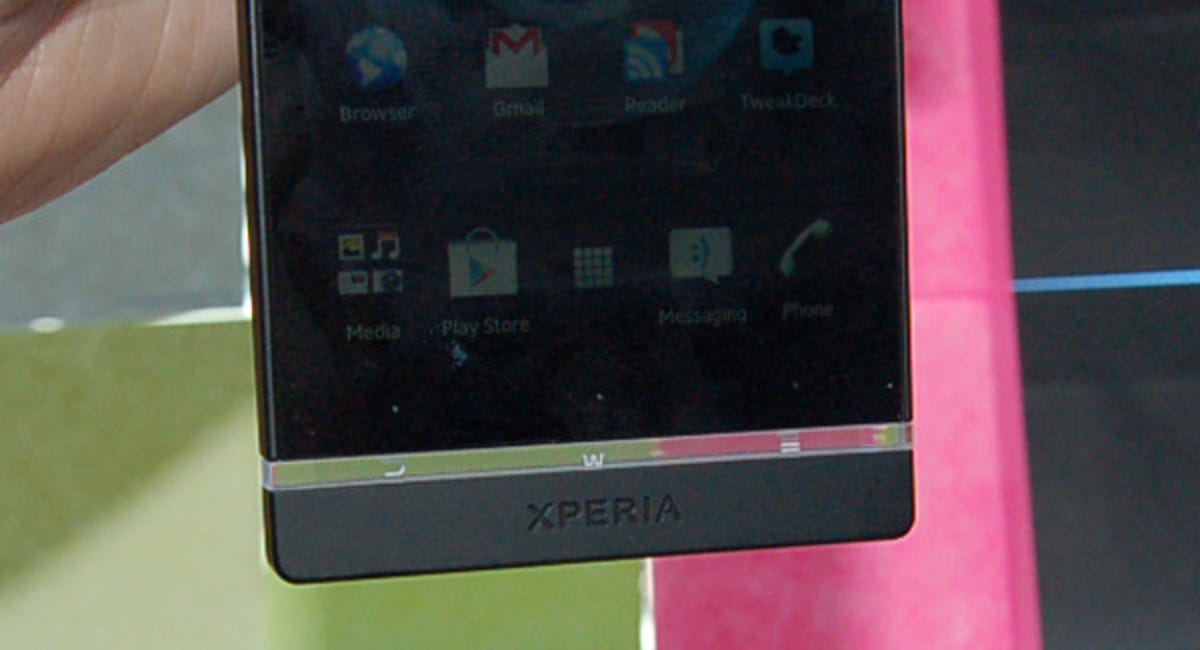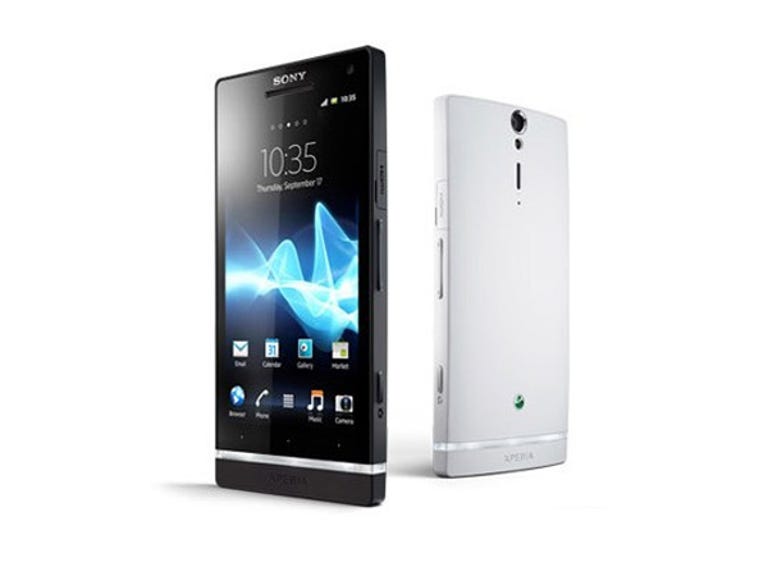 Why You Can Trust CNET
Why You Can Trust CNET Sony Xperia S review: Sony Xperia S
The Xperia S is packed to the gills with great ideas, unique features and solid hardware. An especially good smartphone for lovers of multimedia.
You'll notice the absence of Ericsson in the name of this latest smartphone from Sony, but is this more than a change of name? Has Sony jettisoned the dead weight of Ericsson for the future or are we in for more of the same?
The Good
The Bad
The Bottom Line
Design
The Xperia S doesn't jump out at you the way a coloured phone might, or a phone with an obviously larger display. Sony has chosen quite a demure approach when crafting the Xperia S, and the result is a rather unassuming monoblock with some intriguing additions. Back is Sony's signature "human curvature" across the battery cover, though the curve here is far less severe than in previous releases. Sony covers this area of the phone with a soft-touch plastic and manages to give the S a premium quality feel that so many modern smartphones lack.
Below the display you'll find a transparent plastic strip with the iconic Android navigation icons embedded. This is an attractive touch, but it also houses the phone's antenna, according to Sony.

The clear panel housing the phone's antenna.
(Credit: CBSi)
The 4.3-inch HD resolution screen is the centrepiece of this well-designed device. Sony opts for the same higher-resolution display we'll see throughout 2012 in smartphones (1280x720 pixels) and in this 4.3-inch array this equates to 342 pixels per inch — slightly higher than Apple's iPhone 4S. This display is perfect for everyday browsing, and fantastic for video playback, but it's not without its faults. Off-axis viewing is noticeably poorer than other screens at this price point, and there is an obvious colour banding issue when viewing still images, where colour gradients are displayed as distinct bands of incrementally different shades of colour, rather than a singular, smooth solid.
General phone navigation is performed using three capacitive touch buttons located between the screen and the clear antenna panel. Using these buttons takes a moment's more concentration than you might expect — we found these buttons responded to our input a half-second after we pressed them. For some, this will seem like a fault of sorts, but we wonder whether this is a deliberate design decision aimed at curbing the number of times these keys are pressed accidentally. Either way, it's not really an issue in our opinion.
We do like that Sony manages to include both a dedicated HDMI port and camera shutter release without interrupting the design of the handset. Other manufacturers refuse to include these options so as to maintain clean lines around their products, but Sony proves you can have your cake and eat it, too, in this regard.
Take off the battery cover on the back of the Xperia S and you'll quickly realise that you can't access the battery at all. Sony has encased the handset's power behind another plastic cover so there is no way to carry two batteries and switch one out throughout the day. There is no microSD card slot either, though Sony does include 32GB of internal storage, plus access to 50GB on cloud storage service Box.net.
Performance
Sony's decision to use a dual-core processor in the Xperia S makes sure that this phone keeps pace with other competitor releases, even if quad-core processors are the choice for other phone makers in their top-tier devices. We certainly don't feel this is a deal-breaking decision on Sony's part, as the need for quad-core chips is still very much in question and the performance delivered in the Xperia S seems adequate to us. We have encountered a few small pauses in performance across the user experience, but nothing that really holds this phone back. It doesn't feel like the latest and greatest, but it certainly runs smoothly.
Sony's choice of battery also fails to break new ground, with its 1750mAh battery being a pretty standard capacity for smartphone at this time, and a standard we hope to see superseded in the near future. The Xperia S managed four hours continuous video playback with the screen brightness set to 100 per cent. During a business day with auto-sync on, the battery lasted 14 hours, but this figure more than doubled with lighter use and no auto-sync over a weekend.
The custom Xperia Android overlay takes on a new name and a few cool new features in this release. Now known as NXT, the design of Sony's Android experience is much lower key than HTC's Sense UI, but packed with nice touches. For example, the clock on the home screen can be swiped to the left to reveal a music player shortcut, Sony's Track ID service (like Shazam) now works in the Music Unlimited app, and Sony has designed its own connectivity widget so users can quickly switch on and off features like Wi-Fi, GPS and mobile data. This is one of those phones that every couple of days we stumbled across something else new and undocumented, which is always fun.
We should also note that we've experienced some instability in the firmware that our review unit is running on, with a number of Force Closes occurring during our review period. However, our review unit is not Australian stock, so it is likely that the gremlins causing these minor glitches will be ironed out before its Aussie release.
Camera
One area where Sony is pushing the limits is with its 12-megapixel rear-facing camera. Using Sony's Exmor-R image tech, the camera fares well in low light, and takes some pretty great photos under optimal lighting conditions. We did note that the photos we've taken look quite noisy when we inspect them closely on a PC screen, but on the phone's display they look fantastic.
We were also impressed with Sony's new Quick Launch feature, which can take a photo in about one second from standby mode, using the dedicated camera button. Unlike similar features in other phone models, the Xperia S doesn't just open the camera app when you hold the camera button, instead it fires a shot in the hope that it catches the moment you're about to miss. Interestingly, this feature is disabled by default (to avoid unwanted pocket photos, we assume), but it is easily activated in the camera's settings menu.
The camera on the Xperia S handled images with strong differences in colour temperature well.
(Credit: CBSi)
Good colour, contrast and sharp focus in this photo.
(Credit: CBSi)
Fan service for lover's of the CNET mascot, Ned.
(Credit: CBSi)
Features
Besides the standard suite of smartphone apps and connectivity options, two other features stand out. Like Sony Ericsson model last year, the Xperia S sports a stand-alone HDMI-out port on the side of the handset. Whether you get the necessary micro-HDMI cable is down to your choice of Aussie telco, with only Vodafone including the cable as standard in the sales kit.
The HDMI port on the side of the Xperia S.
(Credit: CBSi)
In itself, HDMI is not such a remarkable feature, but it's the way this phone communicates with your display that we really like. Sony has designed a special TV display that is presented in 720p resolution. Within this TV UI you can launch gallery apps easily, surf the web, check your messages or social networks, or add shortcuts for any of your favourite apps. To control this UI you can use the handset itself, or use your TV's remote control — so long as your TV's HDMI port is CEC compatible and the remote has directional keys. This means that this feature is not limited to Sony-branded TVs or to TVs with a Wi-Fi card. Very smart indeed.
Beyond the uses for HDMI listed above, the feature plays neatly into the united Sony Entertainment player that we've been hearing about lately. The Xperia S has both Music Unlimited and Video Unlimited services pre-installed, and both work best when the phone is plugged into an external monitor or speakers. We tested out the movie streaming service, and though you can only download SD quality movies, we were pleased that you could start viewing the content after the service had downloaded enough of the movie to buffer a stream.
You also get a pair of stereo headphones in the box with the Xperia S, and though we were impressed with the ability of these buds to dull outside noise, the sound they produced is pretty average, with a focus on tinny-sounding high ends.
Perhaps our favourite feature is the included NFC receiver, but like HDMI, it's not the fact that it's there that we like, but how Sony has decided to use it. In the box with every Xperia S sold in Australia are two NFC SmartTags (apparently imported units may not come with these). These tags are used to trigger a list of commands in the phone simply by holding the handset next to the tag for a moment. The tags in the box are preconfigured where one activates a car mode and the other a bedside clock/alarm mode, but these commands are completely customisable. For example, you could set one up so that it turns off Mobile Data, turns on Wi-Fi, pairs with your stereo over Bluetooth and turns on the radio, then you could place it by your front door so that all these tasks can be activated the moment you walk in the front door.
A red NFC SmartTag activating Car Mode.
(Credit: CBSi)
Sony has told us that the Xperia S is also ready for mobile banking, or for a SIM card variant of NFC if the telcos head in that direction. But for now, the included NFC Tags are a fantastic introduction to NFC technology and how it can be used in smartphones. If you find you get good use out of the two SmartTags included with the phone, Sony will also be selling packs of four tags shortly after the phone's release.
One final feature that we feel is worth a mention is Sony's LiveWare software. LiveWare is designed to control the way the phone responds when you use a variety of accessories, for example, which application would you like to launch when you plug in a set of headphones, or do you want a bedside clock app to launch when you connect the AC adapter? It is such a simple feature in concept, but the everyday application of this is fantastic.
Overall
The Xperia S is packed to the brim with great ideas, new tech and hardware that work well. Operating it all is made easy by Sony's good NXT user interface, too. We do wish the LCD panel was better when viewed off-axis and wasn't plagued with colour-banding issues, but these are relatively minor problems that shouldn't detract from the overall experience for most users. If the Xperia S is setting the tone for future Sony smartphone releases then we're in for a real treat down the track.


